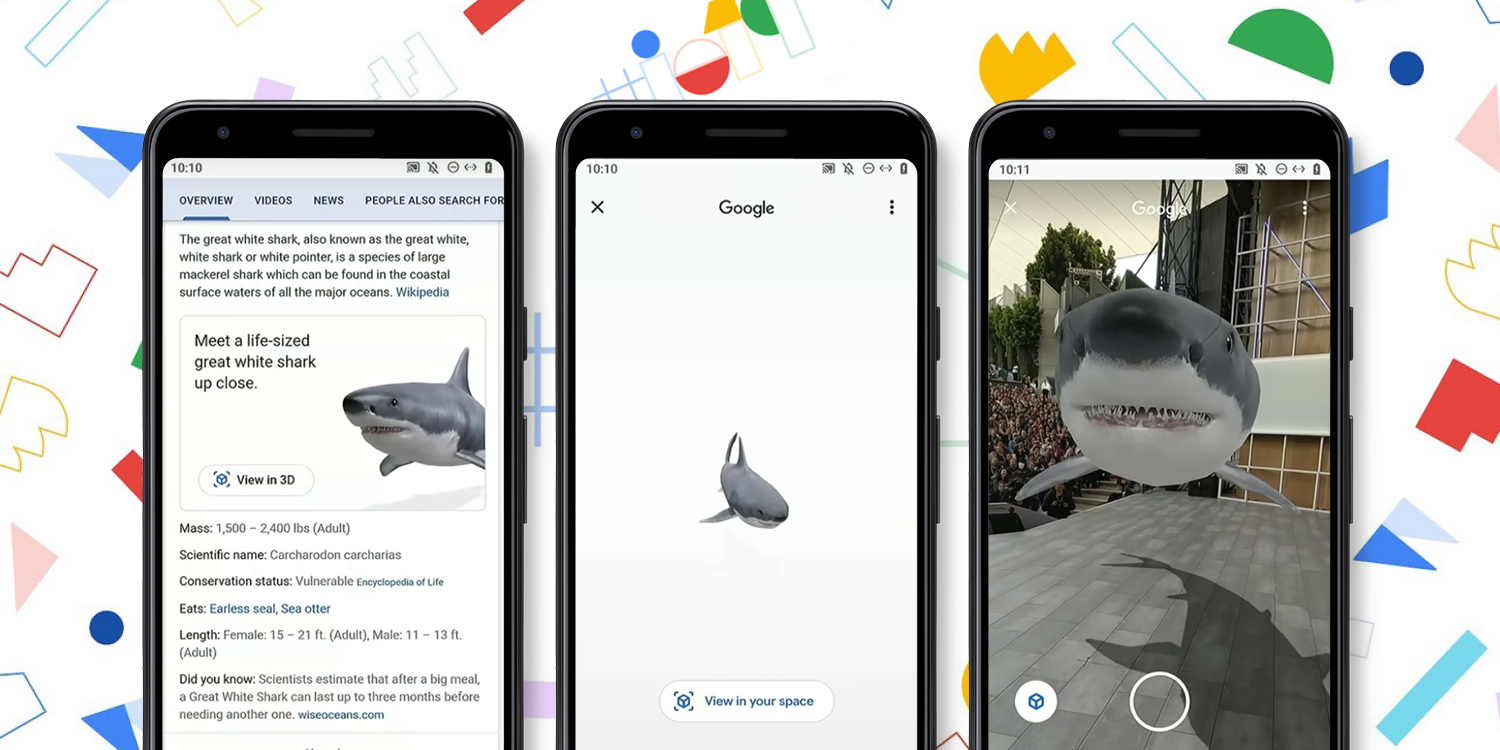增强现实,唾手可得
Augmented reality (AR) feels like it’s on the verge of widespread consumer adoption – and this should excite us! According to eMarketer, nearly 69 million Americans have used AR, representing a gradual a year-over-year increase, and adoption into 2020 is trending upward. We’re about to experience AR even closer to our fingertips as Google looks to integrate it into search via (mobile) web AR.
What could this mean? AR’s consumer adoption barrier is about to be lowered significantly – opening the door for other AR products.
Augmented Reality and Search
AR-integrated search sounds like a simple concept, but experiencing a 3D model in a search result can be more rewarding than merely seeing a flat image. As showcased in a demo at Google’s annual I/O event, (and in this article’s header image) an animated shark swam out of a mobile phone when Google displayed search results for information about sharks, providing the audience not only with an awe-inspired moment but also a more useful way to answer a query about great white sharks.
The ability for users globally to experience AR search so easily will likely:
- Lower the consumer adoption barrier for other AR products
- Increase AR-use
- Increase use cases for AR
We’ve seen similar trends with other technologies as they were emerging, but continues to be amazing to observe as it happens.
I’ve contended before that immersive realities (AR, mixed reality, and virtual reality) become valuable to consumers when they solve real problems, build community, and/or provide utility. But making AR more accessible and familiar are important to inspire adoption.
Source: Google I/O
Google’s Focus on Augmented Reality
For a little background, I/O is an opportunity for Google to showcase new ideas and features that touch all of its products, ranging from immersive reality to voice. In years past, Google has rolled out virtual reality (VR) products. This year, AR was the focus. As Aparna Chennapragada, vice president, Google Lens and AR, wrote,
With new AR features in Search rolling out later this month, you can view and interact with 3D objects right from Search and place them directly into your own space, giving you a sense of scale and detail. For example, it’s one thing to read that a great white shark can be 18 feet long. It’s another to see it up close in relation to the things around you. So when you search for select animals, you’ll get an option right in the Knowledge Panel to view them in 3D and AR.
Onstage at I/O, Chennapragada demonstrated the floating shark, which triggered a flurry of replies on social media and “Oh, wow!” coverage from publications such as Fast Company and The Verge. Now, a great white shark in augmented reality iscool. But even more importantly, the experience as demonstrated by Chennapragada is useful. As she noted, an immersive view of a great white shark makes a search result more meaningful and contextual than a text-based description or a photo. Seeing how a life-size shark moves and getting a close-up of its teeth takes learning on your phone (read: Googling) to a new level.
Chennapragada emphasized AR as a search utility in other ways, such as:
- Learning about human anatomy. She showed how a search for “muscle flexion” might produce see an animated model from Visible Body.
- Shopping. She showed how someone might shop for clothing by superimposing 3D images on one’s person to see how well a purchase might fit.
Source: Google I/O
Google noted that it is working with partners such as NASA, Samsung, Target, and Volvo to surface more of their content via AR in search and likely more partners will be asked to assist in this effort.
Making AR Lovable Through Utility
AR holds much promise in industries such as publishing, tourism, education, and retail: its immersive nature enriches intent-based experiences such as learning and looking for things to buy (read: shopping). In retail, AR is especially useful for high-consideration products that require research. Retailers such as IKEA have responded by creating their own branded AR experiences, including IKEA’s own app that allows you to configure furniture in your own space before you buy it. Additional brands have also started their augmented reality journey, like Walmartand Amazon AR View. The beauty the differentiates what Google is doing is that it’s using (mobile) web AR so that you don’t need to download an app to experience it or accomplish tasks. You just need to, well, “Google it.”
Customers Shape the Future of AR
At Moonshot, we believe in the power and need for empathy-driven design with all of our products and experiences to really enhance or enable the lives of the users. Those experiences need to be designed with users, not just for users. The difference between “with” and “for” is again a small nuance in how we design, but it makes a big difference in the outcome and the associated product adoption.
While we continue to use empathy-drive design techniques when designing for AR, it can still be tough to grasp because the usability and interaction design changes pretty significantly. Yet, we still want lovable designs and lovable products. Some design considerations include the user’s range of motion, the potential manipulation of assets and their interaction, spatial computing, sizing, and many more. Stay tuned as I share lessons from the field on how to design for augmented reality in the coming months!
Meanwhile, I encourage you to think how your digital strategy incorporate immersive reality and if you’re ready for the consumer audience that expects immersive experiences. We can help you get startedwith bringing your immersive reality dreams to life.


